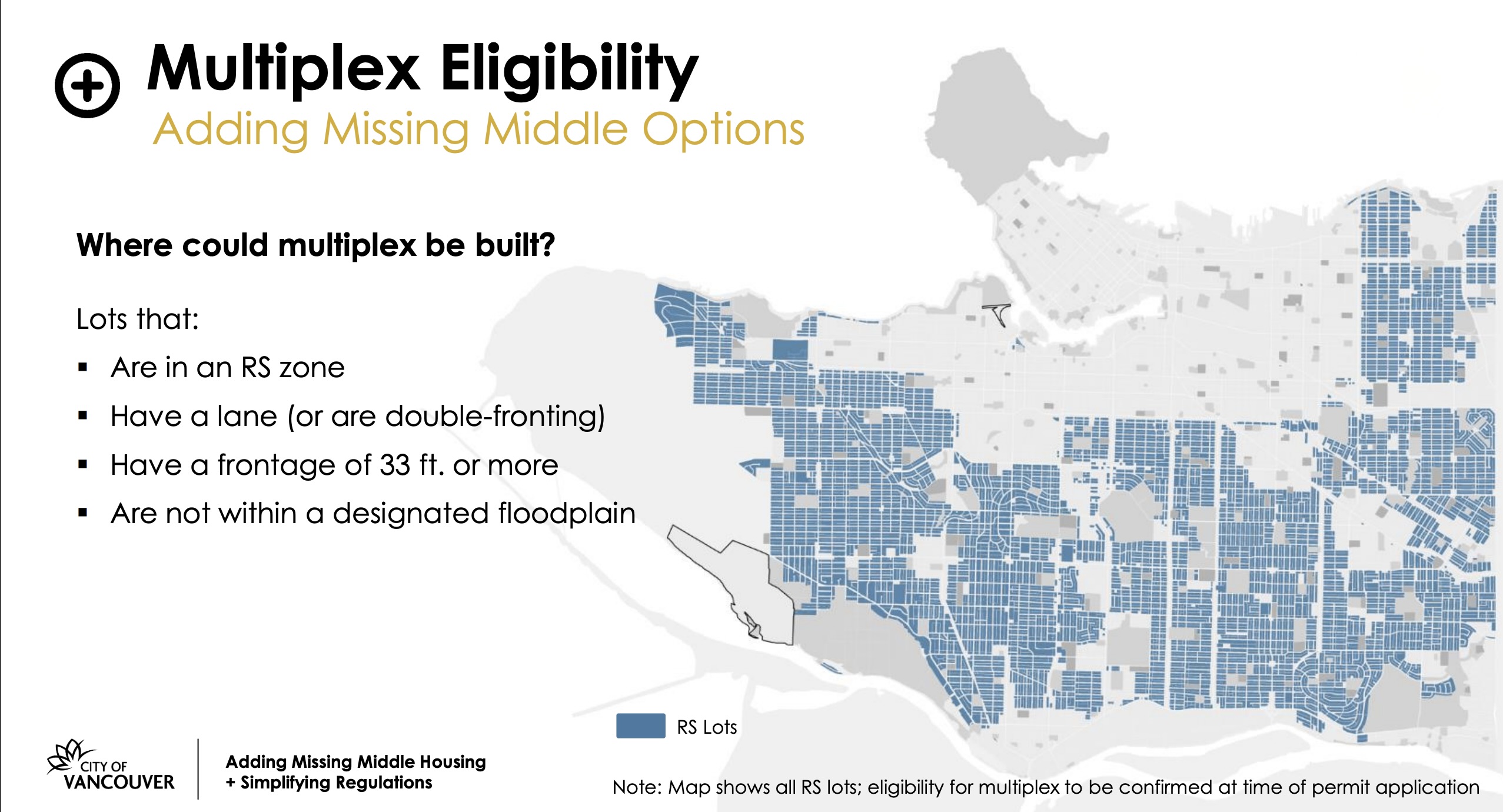
Jun 7, 2023: City survey draws few participants but majority gives nod to middle missing housing
The results are in and the majority of respondents to the Missing Middle Housing (MMH) survey want to see more middle missing housing built in residential neighbourhoods, and they want the rules outlining what developers may and may not build to be simplified and clarified. Keep in mind that out of the entire population of Vancouver, only 1,895 residents completed the survey.
Here are the results, according to the City:
- 77% of survey respondents agree that multiplexes should be allowed in all low density residential areas
- 60% say there should be a reduction in the maximum size of new houses
- 80% agree that the allowable size of new laneway houses should increase
- 74% agree with removing design guidelines, standardizing regulations, and reducing the number of RS zones.
There has been only one zoom information session available to the public about how the MMH will affect neighbourhoods— unusual given the plan will affect all RS zones in the City if approved. UKRA attended the meeting and heard a repeat of the information in the City report, which was followed by questions from residents:
Q: Will heritage properties be exempt from the MMH plan? A: No. Heritage houses are included in the plan, and would only be exempt if the house is legally designated as such.
Q: Will there be assistance to landowners for providing expensive PMT pads —pad-mounted transformers — for charging electric vehicles? (PMTs can cost up to $100,000 Cdn).
A: Not at first. Senior City planner Patricia Huber said that BC Hydro is reviewing the costs associated with PMTs and that it recognizes there are challenges for homeowners. For the first two years or so, said Huber, homeowners must “foot the bill.”
Q: If one of the intents of MMH is to provide homes for families, where will children play without front and backyards?
A: They would have a small patio to play on, said Huber, or they could go to local parks or playgrounds.
Q: Why are the bulk of RT zones excluded from the plan?
A: The RT and RM Zones are historic neighbourhoods, said Huber, noting that these zones will be open to much greater change because of their proximity to transit along the Broadway Corridor. (In Kitsilano, for instance, the Broadway Plan allows new towers ranging from 15 to 25 storeys, and up to 40 floors near subway stations).
Q: Will the majority of new multiplexes be rental or strata?
A: Strata. (Staff has said that one unit on the east side of Vancouver would cost approximately $1.1 million).
Q: Can the landowner reside in one of their own units?
A: Yes. In the case of secured market rental, for instance, the density bonus would be waived, and the owner would be able to reside in one of the units.
Q: What is the maximum number of units allowed on properties?
A: Three to four units are allowed on 33’ lots, four to five units on 44’ lots, six units on 50’+ lots — and up to eight if all units are secured as purpose-built rental housing.
Q: What will be the average size of units?
A: 1,000 sq. ft.
Q: Must homeowners planning to redevelop to MMH notify their neighbours?
A: No.
Q: What is the plan for new laneway houses?
A: If the MMH is approved, laneway houses can be two full storeys.
UKRA’s Major Concerns:
- Trees will be lost in the plan, Huber has confirmed. UKRA is concerned that not enough green space is provided per lot, and that extensive demolition and construction will lead to root damage of 100-year-old boulevard trees.
- The disincentivizing of character and heritage houses will lead to more demolition of the history of Upper Kitsilano.
- By removing design guidelines for new houses, neighbourhoods could wind up with a hodge-podge of styles that have nothing to do with neighbourhood fit.
- Loss of secondary suites, including some of the most affordable rents in the city, and a large rise in “demovictions.”
- Staff estimates that an average strata unit on Vancouver’s Eastside will sell for approximately $1.1 million. What will they sell for on the Westside? Will the plan provide any affordability?
Prioritization Framework for Planning Policy and Processing Applications
ABC Councillors sent a strong message to both the public and their opponents this past Tuesday that they plan to prioritize development projects with the greatest amount of “net” new housing units. That includes market rental, below-market rental, and housing of all types and tenures built across the city over the next four years. It means Vancouver is more likely to see condo development rather than social and below-market housing, at least in the short term — an about-face from the previous Council.
Facing an unprecedented backlog of development applications, City staff had asked Council for direction on how to clear the bottleneck. Staff reports say the City is currently facing nearly double the normal number of rezoning applications. Based on housing targets, these proposals represent approximately three to four years of housing supply based on past housing approval trends. The volume is also in excess of what staff and Council can process through Public Hearings in a single year.
An amendment to the motion regarding the prioritizing of housing projects was made by ABC Cllr. Peter Meiszner, and it passed in an 9-2 vote, with the Green Councillors in opposition and OneCity Cllr. Christine Boyle absent. ABC Cllr. Sarah Kirby-Yung said Vancouver has an “incredibly” low vacancy rate and not the right amount of housing to meet the needs of new residents. She blamed the complexity of permits and processes, which have become the “single biggest impediments” to getting homes built.
Cllr. Adriane Carr said she was “appalled” that the change in priority would put condos and market housing on the same footing as social housing. If developers are given a choice, they will do what brings them the most money, Carr told Council, pointing out that their priority will be market-priced housing.
Cllr. Meiszner disagreed, saying the amendment prioritizes housing of all types. “This is not an ‘either-or,’” said Cllr. Kirby-Yung, “this is an ‘and.’’’
Kitsilano Coalition launches new constitutional challenge to Bill 26
Premier David Eby may have thought the Kitsilano Coalition would back down when he pushed through legislation to quash the group’s legal challenge with the City of Vancouver over the Arbutus Supportive/Social project at West 8th. But the Westside group has launched a second challenge, saying that Bill 26 violates the Canadian Constitution.
“Bill 26 unlawfully deprives Canadians of their constitutionally-protected access to the courts and usurps the constitutionally-protected jurisdiction and responsibility of our courts to hold public decision-makers accountable and safeguard the rule of law,” announced Peter Gall, KC. Gall, a former Justice of the Supreme Court of Canada, will argue the group’s case in BC Supreme Court. He is joined by Justice J.E. Michel Bastarache, CC, KC. Gall and Bastarache are partners of Gall Legge Grant Zwack LLP.
In a Coalition press release, spokesperson Karen Finnan said, “Bill 26 targets only the Arbutus and 7th/8th site. The willingness of elected representatives to enact legislation that disregards constitutional rights should alarm every resident of this Province.”



No Comments